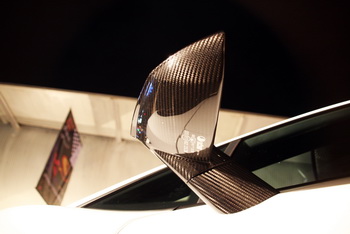

 |
|
The latest example of the company’s
successful use of carbon fiber is the new
Lamborghini Gallardo LP 570-4 Superleggera
(above, as one of the stars of a Korean
Grand prix launch party in Bangkok last
night), which weighs only 1,340 kg and whose
weight-to-power ratio is best in class in
its super sportscar segment. |
|
|
|
Lamborghini has reported
a turnover of 152.9 million euros for the first six
months of the year. This value is only slightly behind
the level of the previous year's period, which was 156.9
million euros (-2.6%). In terms of unit sales, the
company delivered 674 cars with the raging bull logo,
while in the same period of 2009 deliveries totalled 825
cars (-18%). The almost stable turnover is due to a
different sales mix and exchange rate effects.
On a global scale, sales are supported by substantial
growth in Asia-Pacific. In particular, Lamborghini shows
a sales momentum in China that represents increasing
global relevance. With an increase from 28 to 86 units,
the sales in the Chinese market marked a 200% growth.
China is already the second largest market for
Lamborghini. In the same region, Australia, Singapore,
Hong Kong and Taiwan are all contributing to the strong
upwards trend, with some markets growing at a rate of
more than 100%. All of Asia-Pacific now accounts for 34%
of sales compared to 15.8% in the year before.
The President and CEO of Automobili Lamborghini, Stephan
Winkelmann, commented, “As we expected, 2010 is a year
of transition for Lamborghini, in which we are
positioning the brand for the next steps of its global
evolvement. The success of our Asia-Pacific strategy
clearly shows the soundness of our global road map. With
the traditional markets eventually recovering as well as
with the Asian market dynamics gaining further momentum,
with new products based on the newest technologies,
Lamborghini will come out of this challenge stronger”.
Winkelmann confirmed that Lamborghini will remain steady
on its long-term strategy, investing in the future with
product technology and innovation. Strategically,
Lamborghini focuses technological development on the
optimization of the super sports car by consistent light
weight construction. “The most important parameter for
super sportscars is, now as in the future, their
weight-to-power-ratio. As there is a limit to power
increase due to emission regulations we must work on
weight reduction. Extensive use of carbon fiber, even at
a structural level, allows Lamborghini to be at the
forefront of development techniques”, Winkelmann
emphasised.
Proof of Lamborghini’s dedication to this target is the
recent realization of an all new center for carbon fiber
research within the company´s headquarters in Sant´Agata,
Bolognese. The Advanced Composites Research Center (ACRC)
has been established to secure leading-edge research on
innovative manufacturing methods for carbon fiber
elements for small production volumes. The engineers
have already achieved a breakthrough in the production
process of composites by combining benefits of several
existing methods. Thanks to the patented “RTM light”
process, Lamborghini can use minimal pressure and low
temperatures in the manufacturing of carbon fiber
components to the highest levels of quality, precision
and surface finish.
The new ACRC works alongside its partner laboratory, the
Advanced Composite Structures Laboratory (ACSL) at the
University of Washington (Seattle, USA). The ACSL was
opened by Lamborghini at the end of 2009 together with
The Boeing Company. The latest example of the company’s
successful use of carbon fiber is the new Lamborghini
Gallardo LP 570-4 Superleggera, which weighs only 1,340
kg and whose weight-to-power ratio is best in class in
its super sportscar segment.
Investments into R&D and into reduction of CO2 emissions
will continue as planned, resulting in continuing
technology and product innovation. Lamborghini is
implementing a broad sustainability program through
different product innovations and technologies: the
manufacturer aims to achieve a 35% CO2 emission
reduction in cars by 2015. On the production process
side, Lamborghini will reduce this year’s CO2 emissions
by 30% thanks to a photovoltaic system inaugurated last
February.
|
|
|